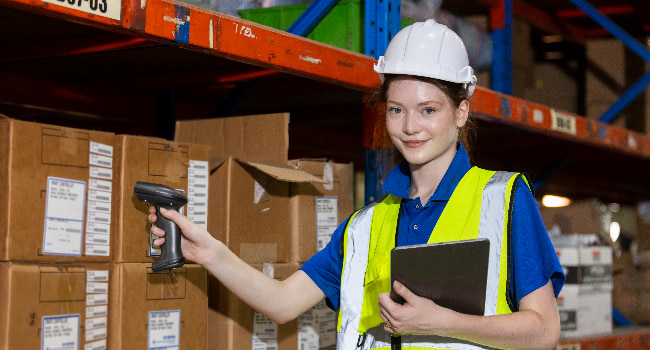A1 Quality Logistical Solutions
Key Highlights
- Uncover the 10 crucial KPIs that drive warehouse success and enhance supply chain operations.
- Learn how measuring inventory accuracy, order cycle time, and labor productivity can lead to better customer satisfaction and significant cost savings.
- Discover operational strategies like leveraging warehouse management systems and automation to streamline logistics processes and improve decision-making.
- Understand the importance of aligning KPIs with strategic goals to efficiently manage warehouse space and distribution services.
- Gain actionable advice on reducing shipping costs while optimising inventory management and order fulfillment rates.
Introduction
When a warehouse runs on lean ideas, it helps cut down waste, makes sure things move well, and uses resources in the best way. As customers want more, the pressure to make every part of logistics work better and fix weak spots also goes up. Lean warehousing is a way for businesses to change, improve, and stay strong in the market. In this blog, I will take you through what lean warehousing is, its benefits, and how you can use its methods to make your supply chain work better.
Understanding Warehouse KPIs
Key performance indicators, or KPIs, are tools to see how well your warehouse is running. The right KPIs help you understand things like inventory management, how fast you can get orders out, and your customer satisfaction. These measures are key for good business intelligence, so you know what is happening in the warehouse.
When you use these KPIs, warehouse managers can focus on areas that need to improve. Picking effective KPIs that fit with your business goals helps make sure that you are moving in the right direction. This way, you can measure how things are going with more accuracy and make changes where they will do the most good.

What Are Warehouse KPIs?
Warehouse KPIs are measurements that help you see how well the warehouse is working. These show things like how accurate the inventory is, how good your order fulfillment rates are, and how much work is being done by staff. Some KPI examples include looking at how fast you use up your stock and checking how often orders are picked right.
You can put KPIs into different types. Some KPIs are called strategic KPIs, and they look at long-term goals. Others are operational KPIs, which are used for short-term goals and focus on the steps in your daily work. Both types matter. They each help different parts of the business in their own ways.
Good KPIs match up with your warehouse’s strategic objectives, and they be clear in what they measure. You should not try to track everything. Only focus on the KPIs that matter for customer satisfaction and your warehouse’s results. When you are careful with your KPIs, you do not waste time, and your choices are better because you use real information.
Why KPIs Matter for Warehouse Operations
KPIs are key to help you see if your project is on track. They are important for reaching your bigger business goals. These indicators check how well work gets done in the warehouse, such as how well people work and how smooth your transport is. They make sure you and your team are moving towards what the business wants.
KPIs also help make choices easier. For instance, watching the on-time shipping rate can show problems in how shipping is handled. This means you can change how you ship things for better results. When you watch the KPIs that are most tied to your business goals, you get to make your work better and use what you have in the best way.
Also, KPIs show if teams give real value or not, so you can fix problems before they get big. When you keep a close eye on your KPIs, your warehouse can do what customers look for and stay ahead in a fast-changing world.
How to Select the Right KPIs for Your Warehouse
Choosing the right KPIs for warehouse work takes care. You want to use tools like a balanced scorecard to be sure the KPIs you pick match the specific functions and the big strategic goals you have.
Start by looking at strategic KPIs that help reach the company’s top objectives. This could be things like making inventory more accurate or cutting down on how long order fulfillment takes. The best KPIs should be easy to measure, do something, and link straight back to the goals you have. For example, checking labor productivity can show where to get better at managing the people who work for you.
Next, do not pick too many numbers to watch if they will not help you make real changes. Just pick a few good KPIs that give a balanced look. This means some should be leading indicators, like tracking order volume, and others should be lagging, such as looking at what happened with shipping results. At the end, keep reporting clear and on time. These KPIs need to give regular info that helps to increase productivity and make better choices as time goes on.
Inventory Accuracy
Inventory accuracy means that the numbers in the system match the real stock that is in the warehouse. Warehouse workers need to trust this information during the fulfillment process so there are no slowdowns or mistakes.
Keeping track of inventory accuracy helps you make better decisions for forecasting, buying new stock, and keeping the supply chain moving smoothly. When inventory accuracy is high, you can avoid spending too much money, and this also leads to better customer satisfaction. Next, we will talk about why inventory accuracy is so important and ways you can make it better.

Definition and Importance of Inventory Accuracy
Inventory accuracy means checking how well the items you have match what your warehouse management system says. When you have good tracking, it helps you fill customer orders on time. This stops you from running out of items or having a surplus.
When your inventory is accurate, your customers are more likely to be happy. If your records are wrong, it can slow down shipping or cause mistakes. These mistakes can hurt your reputation and make you spend more money. Having correct numbers helps you make better decisions when you buy more products or try to plan for the future.
Keeping your inventory correct makes your business run better. This helps your people use their time in a good way. It makes supply chain and supply chain management easier. You also save money and work more smoothly. In the end, it helps you get cost savings and keeps things on track for your team and your customers.
Methods to Measure Inventory Accuracy
Measuring inventory accuracy means checking different parts of how the warehouse works. Some common kpi examples are checking for mistakes in the counts and how right each check is.
Measurement Method | Description |
Cycle Counting | At times, they check some of the inventory to see if what you have matches the records. |
Discrepancy Rate Analysis | They work out the difference between what is on paper and what is really in the warehouse. |
Annual Physical Count | Every year, there is a big check of all stock to see if it lines up with what is in the system. |
A good warehouse management system can be used to handle these checks and give you updates in real time. It can also help find mistakes. Doing this shows you if your supply chain is healthy and helps spot what needs to be fixed or made better.
Strategies to Improve Inventory Accuracy
Boosting accuracy with inventory management calls for good planning and careful action. Here are some simple things you can do:
- Implement Warehouse Management Software: Use tools to track inventory. This can cut out mistakes people might make.
- Adopt a Regular Cycle Counting Schedule: Check your stock in smaller parts and do it often.
- Train Warehouse Workers Effectively: Make sure workers know inventory steps well. This helps things be more correct.
- Integrate Predictive Analytics: Use data to help guess what your supply chain will need and keep things balanced.
When you finish these steps on time, you will see less errors in order picking, save money, and make your whole inventory management better. This approach will also help you run your business in a smoother way and keep your supply chain steady.
Order Picking Accuracy
Order picking accuracy shows how often warehouse workers pick the right items for each order. When there are too many picking mistakes, the wrong products get shipped, and this can upset customers. In ecommerce fulfillment, it is very important to get it right every time. Customer satisfaction depends on it.
There are some good ways to make order picking better. You can have strong training programs for workers. Using clear order tracking systems will help stop problems before they happen. Some places also use automation tools to help workers pick the right items faster. When you do not try to make picking better, it will cost you more money, and the company’s name can become less trusted. Let’s look at what causes picking mistakes and find out how to improve this important metric for us all, so that we meet customer expectations in ecommerce fulfillment.

What is Order Picking Accuracy?
Order picking accuracy shows how well the items picked match what the customer ordered. Getting this right is very important for customer satisfaction. It also helps to cut down on returns and keeps the operation costs low in a warehouse. Doing regular checks and giving workers good training can help to improve this key number.
Common Causes of Picking Errors
Miscommunication is often one of the main reasons for picking errors. This can happen if labels are not clear or when workers do not have enough training to use the warehouse management systems. If the inventory management is not good, this makes it hard to keep stock counts right and affects order fulfillment. Distractions and tiredness can also make warehouse workers miss small details, which causes mistakes while they pick items. There can be even more mistakes in customer orders if logistics operations are not organized well or when the warehouse layout is not set up in a good way. All these problems can make order picking harder for workers and lead to more errors.
Best Practices for Boosting Picking Accuracy
Improving picking accuracy helps make order fulfillment smoother and raises customer satisfaction. You can use clear labeling and warehouse management software to make things less confusing and cut down on mistakes. Giving regular training to warehouse workers will help them stay up-to-date with the best picking methods.
When you bring in tools like barcode scanners and mobile devices, you can track inventory in real time. This helps you make faster choices. Setting strategic KPIs that focus on picking accuracy can move things in the right direction. This helps your warehouse run better and work toward business goals, so your customers have a better experience.
Order Cycle Time
The order cycle time covers every step, starting from when people place their order up to when the order goes out the door. This affects inventory management a lot and shapes how happy customers will be when they get their things. When businesses pay attention to the main KPIs for this, they can spot problems in their supply chain operations. This makes it easier for them to make better decisions, fix weak spots, and work in a more efficient way. Making the order process faster and smoother leads to real cost savings, helps build a good shipping strategy, and also keeps more customers coming back. All these steps work together to meet their strategic objectives, which is a must in the busy world of ecommerce right now.

Understanding Order Cycle Time
Order cycle time shows how long it takes from when a customer places an order to when the order is finished. This is an important measure in warehouse work. It tells you how well you are handling inventory management and order fulfillment. When the cycle time is shorter, customers get their orders on time. This helps improve customer satisfaction and gives a better customer experience.
In the supply chain, knowing about order cycle time helps you make better choices, run logistics operations well, and lower shipping costs. Watching this number also keeps your work in line with your strategic goals. It lets you use decision making to keep up with what customers need.
Factors Affecting Order Cycle Time
Several things can have a big effect on order cycle time and how well things run in a warehouse. Inventory turnover rates matter a lot in this. When you keep the best amount of stock, you get faster order fulfillment. Also, using an accurate inventory management system makes order processing faster because products are easy to find.
Logistics services also play a large part. With good transportation management, your orders get to you faster. The way a company sets up its warehouse space matters too. If it is well organized, people can get to products quickly. This not only makes the order cycle time shorter but also helps with customer satisfaction overall.
Ways to Reduce Order Cycle Time
Making the order fulfillment process faster can help cut down the time between when a customer places an order and when they get it. This can improve customer satisfaction in a big way. Start by using a good warehouse management system. It will help with tracking your stock, make orders more accurate, and help you make better choices for your business.
You can also try other picking methods, like batch picking or zone picking. These can help you get orders out the door faster. It’s a good idea to look over your logistics operations often. Find any slow spots and look for ways to make your workflow better. Using new technology also helps in supply chain management.
Strong communication is key. Keep warehouse workers and transportation services updated, so everyone stays on the same page. This will make your fulfillment process run smoother and help you reach your strategic objectives.
On-Time Shipping Rate
Keeping a high on-time shipping rate really matters for customer satisfaction. It also helps with order fulfillment and makes logistics operations better. When you track this KPI, you can see where problems come up. This helps people find ways to make things run faster and give a good customer experience.
With business intelligence tools, companies can spot which trends matter and make better decisions about their shipping strategy. When you focus on sending orders out on time, it lowers shipping costs. It also helps get higher customer service ratings, which means customers are more likely to come back and buy again. This is a good way to hold onto or grow market share.

Measuring On-Time Shipments
Setting up a way to measure on-time shipments is very important for tracking how well your logistics operations are doing. Using effective KPIs like the percentage of customer orders shipped on time vs. total orders helps you see important trends. This kind of measurement shows how efficient the supply chain is, and can show you if there are any problems slowing down transportation services.
A good warehouse management system can help improve how well you track shipments. This makes sure customer orders are handled fast and correctly. You can also collect feedback from customers to find what could be made better. Doing these things helps raise customer satisfaction and makes your whole supply chain management stronger.
Impact of Delayed Shipments on Customer Satisfaction
Delayed shipments can hurt customer satisfaction. Getting orders on time plays an important part in the customer experience. In ecommerce businesses, people expect quick order fulfillment. When there is a problem with shipping, it makes customers feel upset. Some may start to think about not sticking with the brand. When customer satisfaction goes down, it can lower net promoter scores. This means fewer people might talk about the brand or come back to buy again. As a result, market share can also drop. It is important to keep logistics operations and transportation services running well. This helps meet customer expectations. When businesses focus on shipping orders on time, it protects their brand. They will also build a better and stronger bond with their customers.
Improving On-Time Shipping Performance
Improving on-time shipping depends a lot on making your logistics operations and fulfillment process better. You can use a strong warehouse management system to track real-time data about your inventory, order updates, and shipping timelines. This kind of tracking helps you and your team make better decisions.
It is good to have clear communication between your customer support team, warehouse workers, and shipping partners. When everyone works together, you can quickly solve any problems or delays that might come up.
You should also watch key performance indicators, like your on-time shipping rate. Doing this helps you find what is not working well in the supply chain. By fixing these problems, you raise customer satisfaction and make everything run more smoothly and efficiently.
Receiving Efficiency
Using good ways to track how the warehouse does at receiving, including effective KPIs, helps to follow how fast and well goods come in. Because of this, orders will be sent out on time. Watching these numbers helps you make better choices. It also helps the business save money and give better customer service.
Making the receiving steps easy and straightforward with a warehouse management system helps you keep good track of inventory. It also helps get orders out the door faster. Using new tools can help warehouse workers do their job in a better way. This better receiving efficiency means good things for customer experience and keeps everything moving the right way in the fulfillment process.

Key Metrics for Receiving Efficiency
Reaching the best results in receiving goods depends on a few important facts. First, keeping track of how much time goes by from when the goods come in to when they go into inventory can help you spot any problems. Also, checking that the items you get match the purchase orders is a good way to manage inventory. This cuts down errors and helps boost customer satisfaction. When you notice how often mistakes happen in receiving, it gives you another clue about how things are going in logistics operations. These facts help the company know what changes to make, so they can make their receiving steps better. By using these key points, businesses can work on their process and do better with inventory management and customer satisfaction.
Streamlining the Receiving Process
Efficiency during the receiving process is key to making warehouse operations better. Using a clear system like standard operating procedures (SOPs) can help things run more smoothly. It can cut down on slow parts, make it easier to do inventory management, and help everyone get more done. Advanced warehouse management systems make it possible to track what comes in right away. This gives the team up-to-date info on what’s in stock.
Also, training is very important for warehouse workers. When people have the skills they need, they can follow best practices every day. It is a good idea to use new technology, like barcode scanning and automated data taking. This cuts down on mistakes and makes it easier to move things from the receiving area to storage. All of these steps help improve the whole supply chain.
Tools and Technology for Better Receiving
Using new tools and the right technology in the receiving part of a warehouse can really help make the work faster and better. When you use things like barcode scanners and RFID, you make sure items are checked in right and you have fewer mistakes with inventory tracking. Warehouse management software lets you see stock levels as they change. This helps warehouse workers know where to put items and how to keep things organized.
Bringing in these technologies makes the receiving job easier. It also helps with important goals, like customer satisfaction and inventory management. In the end, you get cost savings and better results for the business.
Space Utilization
When you make the best use of every area, you can get more out of the space and keep costs lower. Using warehouse management software gives you better information about inventory management and helps you make better decisions about where to put your stock.
Automation tools also help by making the fulfillment process quicker and cutting down on manual work. If you use data analytics, you can find parts of the warehouse that are not used enough. This means your logistics operations can match up with your important plans and strategic objectives. All these changes help cut down shipping costs. They also improve customer satisfaction and boost how well your business does overall.

Calculating Warehouse Space Utilization
Calculating how you use your warehouse space is very important for making the most of what you already have and getting more done. It is about finding out how much of the space is actually being used compared to the total space you have. This measurement is a leading KPI in warehouse management.
To do this well, you need to watch your inventory levels. You also have to check how storage is set up and look at the numbers for how much stuff is moving in and out. Using data from warehouse management systems can help you see if there are spots in your warehouse that are not being used much. With this info, you can fix storage layouts and save money. Good tracking helps you make smart choices and leads to better order fulfillment, lower costs, and a smoother supply chain. It also gives your customers a better experience.
Optimizing Storage Layouts for Maximum Efficiency
Good storage layouts help a warehouse work more smoothly. This also makes order fulfillment faster and better. Using both fixed shelves and moving shelves helps make the most of the space you have. With warehouse management software, you can handle inventory management in a smart way. It is easy to adjust for the order volume and what products are in demand. Clear aisles and putting products in the right spot help people get to items quickly, making it faster to pick out orders. When you look at how well your layout works using important measurements, you can decide what changes will help. This lets the business meet organizational goals and make the best use of space in the warehouse.
Leveraging Automation for Better Space Utilization
Using automation can help you make better use of space in a warehouse. When you use advanced warehouse management systems, you have real-time tracking of inventory. This helps to set up the best storage layouts and you can change them when order amounts go up or down. Automated retrieval systems can cut down the time spent looking for products. This boosts how smoothly you do things. Plus, robots can take care of simple tasks. This lets warehouse workers focus on work that is more detailed, so they help with better choices and your strategic goals. When you bring together automation and space use, your logistics operations run better. In the long run, this approach gives most businesses real cost savings.
Labor Productivity
A high level of labor productivity is key to making warehouse work better. It helps make order fulfillment fast and keeps shipping costs low. Both of these things are important for customer satisfaction and the overall customer experience. Using clear ways to measure how much work warehouse workers do can help spot what needs to get better. Good training programs and fair incentive systems also help people do better at work and feel more motivated. When a warehouse brings in new technology, it can make the workflow smoother. It also gives business intelligence to managers so they make better choices. These choices help keep the company moving toward its strategic goals, make productivity better, and save money in the long run.

Metrics for Measuring Labor Productivity
Assessing how well people work in a warehouse means using the right strategic KPIs to check performance. One of the main things to look at is how many customer orders are processed each hour. This number shows how fast and well workers get things done. Another important thing to watch is the labor cost for each unit, because this shows how good productivity is to the company’s total costs. You should also keep an eye on overtime and workers missing work. These numbers can tell you a lot about how steady and involved the team is, and these things matter for how much work gets done. When you use warehouse management software, it gets easier to collect the right data. The software helps you get facts and ideas you can use to make better choices that will support your organizational goals.
Training and Incentives for Improved Productivity
Improving how things work in warehouses depends a lot on good training and smart rewards. Giving warehouse workers full training helps them get the right skills. This helps make order fulfillment faster and have fewer mistakes, which makes customer satisfaction better. When you add rewards, like bonuses for doing well or praise from the team, employees feel more motivated to meet and beat their goals. This way, people do better work and everyone stays focused on what the company wants. Giving team members special training and rewards can help businesses get more done and work better in logistics operations and supply chain management. This can bring better results in the supply chain.
The Role of Technology in Enhancing Labor Output
Adding technology to warehouse operations helps people work better. This boosts both efficiency and productivity. Tools like warehouse management systems (WMS) let you watch inventory and orders in real time. This makes the fulfillment process move faster and smoother. Automation tools such as robotic picking systems cut down the need for hands-on labor. Because of this, warehouse workers get to do harder tasks.
Data analytics also helps by showing how labor is doing. This information lets management make better decisions. Using business intelligence, a company can match its strategic goals to new technology. This helps reach higher customer satisfaction and makes supply chain operations run well.
Rate of Return (Returns Processing)
The rate of return is a key number to look at when checking how well returns are handled in the supply chain. When you understand this rate, it helps your business spot patterns and control inventory. This also plays a big part in customer satisfaction and loyalty. There can be many reasons for high return rates. Sometimes, it is about product quality or issues with order fulfillment. If you improve customer support and use better reverse logistics, you can cut down on returns. This will help your business do better. Looking at these trends also shows you what customers like and do not like. This gives you good information to use when working on product development or planning new marketing campaigns.

Understanding the Rate of Return KPI
Looking at the rate of return KPI is very important for companies that want to make their order fulfillment better. This number shows the percentage of items that get sent back in a set time. It helps you see if customers are happy and if inventory management is working as it should. When you look at this information, you may learn about common problems, like product defects, shipping mistakes, or if what the customer gets is not what they thought. By using this data well, businesses can improve how they handle reverse logistics, sharpen their marketing campaigns, and make the customer experience better. If returns are handled the right way, it saves money, helps customer satisfaction, and even makes people more loyal to the brand. All this can help the company do well for years to come.
Managing and Reducing Returns
Effective management of returns is key for improving customer satisfaction and the way you handle inventory management. To get the best results, use a strong reverse logistics plan. This helps you spot patterns in returns, so you can find out why they happen so often. When you look at the trends in your returns, you get useful ideas about your product and the customer experience. This way, ecommerce businesses can make better choices.
Your strategic objectives should match your goals for handling returns. This makes sure your return rates do not hurt your cash flow or gross profit margin. By working on the fulfillment process, you can cut down on how many items come back. This improves your sales channels and helps people feel more loyal to your business.
Analyzing Return Trends for Continuous Improvement
Understanding return trends can give you helpful ideas about how well your order fulfillment is working. When you keep a close watch on this data, you can see if there are problems with product quality, customer service, or how orders are packed and sent. If you look at these patterns, you can make changes in your inventory management or in how you ship things. This can help you save costs and make customers happier.
Using business intelligence tools to track return trends helps you make better decisions for your business. This supports your organizational goals and helps improve the customer experience. Working on this all the time is not only about hitting business targets. It is also about making your processes better, so your business can work well and grow its market share.
Conclusion
In today’s changing world of supply chain management, it is very important to keep track of effective KPIs like order cycle time and on-time shipping rate. By watching these numbers, business owners can know what to improve. This helps them boost customer satisfaction, save on costs, and get better at what they do. When organizations focus on always getting better, they can change fast to fit new market needs. Using data-driven ideas helps ecommerce businesses fix how they handle their logistics operations. This gives a better customer experience, meets strategic objectives, and helps them grow in the right way.
Frequently Asked Questions
How often should warehouse KPIs be reviewed and updated?
Warehouse KPIs need to be checked every three months. This helps to see if your goals and daily work match. But if there are big changes in the way things are done or in the market, you may need to review these KPIs more often. When you review these numbers often, you can spot trends faster. It also helps you make the right changes to get the most out of your warehouse.
Can technology help improve warehouse KPI performance?
Yes, technology can help a lot to get better results for warehouse KPIs. It does this by doing jobs automatically, giving real-time data, and helping teams talk to each other better. When you use tools like inventory management systems and analytics software, you can make your warehouse run smoother. You can also keep a close watch on the things that matter most for your warehouse.

Haley serves as the Marketing Manager for A1 Quality Logistical Solutions. She joined A1QLS in 2023 with her prior experience gained with GXO and XPO Logistics.

